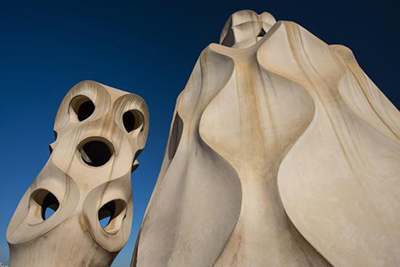The medium of sculpture within Gaudi's career overlaps many of the other disciplines in which he was involved - impacting both his architecture as well as the interiors of his buildings. He also made use of a great variety of materials too, including iron, ceramics and glass.
Antoni Gaudi was someone who liked to keep an eye on every last detail of his projects. He found himself designing the original buildings, as well as everything within them and would use sculpture both inside and out. He was a student of classical design but also invented some of his own techniques which left behind a great variety of work which was aimed at meeting the different tastes of his many customers. He was capable of offering religious themes or leaving them out completely, as well as delivering urban tastes or providing something entirely organic. Creatures would appear within his designs, sometimes as genuine sculptures that would then be inserted into the existing set up. In overseeing every element of these projects, everything would always blend together perfectly and achieve a great consistency.
The artist as a student would learn many different artistic techniques and then he would develop each of these skills as his career progressed. His abilities as a carpenter would then enable him to potentially produce wooden sculptures, and he was also talented in wrought ironwork which again could be used for furniture or sculpture. His ability to blend these contrasting materials together was one of the secrets of his success. He did not overly plan his designs, mainly concentrating on the architectural structures that could not easily be altered later. His decorative touches, such as his building facades or independent sculptures would then be added afterwards and there would be a certain level of creative freedom used, perhaps just with some rough sketches to work from. He did not like to over think in the earlier stages of his projects, keeping his mind fresh and leaving plenty of exciting ideas left for the future stages.
This creative Catalan was not your usual interior designer, nor sculptor, nor architect. He was, in fact, all three together and this combination meant that he ran themes directly through every aspect of his projects, even though this level of involvement would slow down the project considerably. This is sometimes termed multifunctional design. His most famous design was the Sagrada Família, which is still not complete. He created a number of sculptures figures for this huge project and initially would create poses through wire figures, testing and tweaking until he was happy. Plaster casts would be derived from those in order to get closer to the final pieces, which would eventually be constructed from stone. Although he passed away many years ago, many of his original plans for the Sagrada Família were discovered and protected, with most future development of this project being based as closely to what he intended as possible.
Typically, artists will discover a huge range of options for their work as students, being introduced to all manner of different ideas which will excite but also confuse them, in terms of which direction they wanted to head. In terms of Gaudi, though, it was entirely suitable, as he would choose to make use of almost all of these at some point in his career. He called on the services of Eudald Puntí, Llorenç Matamala and Joan Oñós, plus a number of others, through a series of workshops in which he would be introduced to the key techniques involved in all manner of artistic disciplines, such as sculpture, carpentry, wrought ironwork, stained glass, ceramics and plaster modelling. Many would eventually be used in conjunction with each other, such as his plaster modelling which helped him to plan sculptures in stone or metal that would eventually be installed within some of his constructions.
Even a master like Gaudi would eventually need to call on the support of others in order to complete his projects. He built up trusting relationships with a number of highly skilled craftsmen with whom he felt comfortable in allowing to complete various tasks that he did not have the time for. These would be individuals that he met across the course of his career and slowly but surely they would both start to understand each other and then provide a consistent series of works which fitted Gaudi's intentions. In terms of sculptors, he would work with the likes of Carles Mani, Joan Flotats, Llorenç Matamala, Joan Matamala and Josep Llimona. It was essential that these figures were both skilled in their craft, but that their styles also complemented Gaudi's, otherwise huge inconsistencies would have appeared within the larger projects. Modernism was a growing trend within Catalonia during Gaudi's lifetime, though, so it was easier for him to find suitable colleagues than if he worked in an alternative style.




